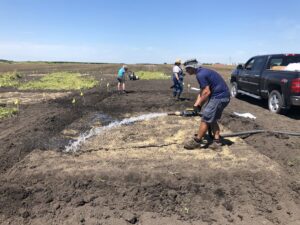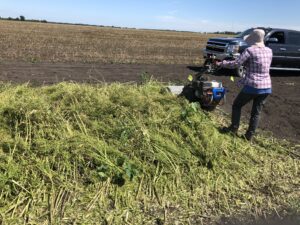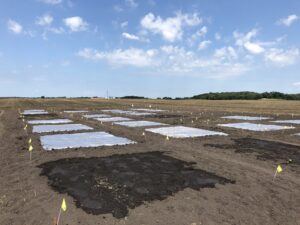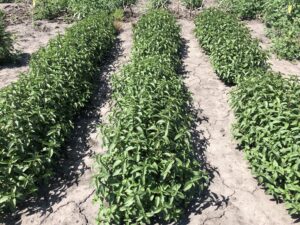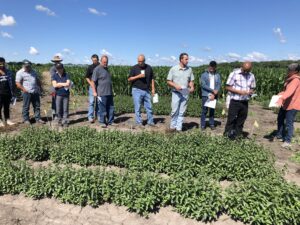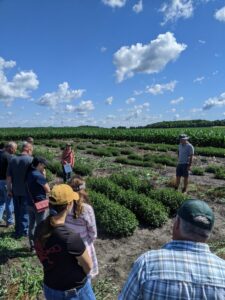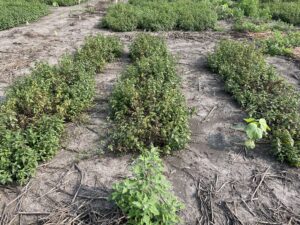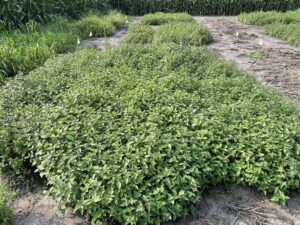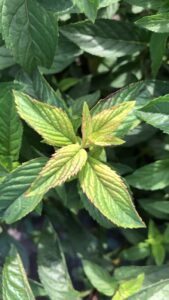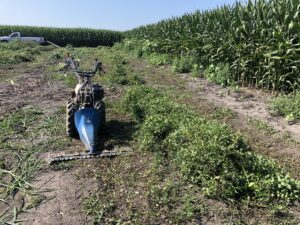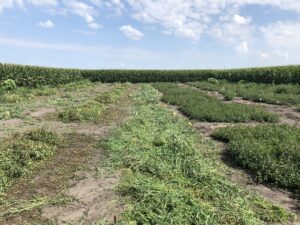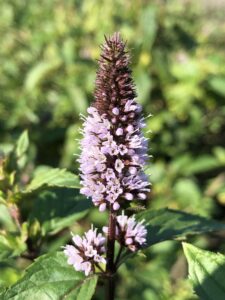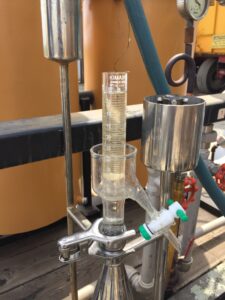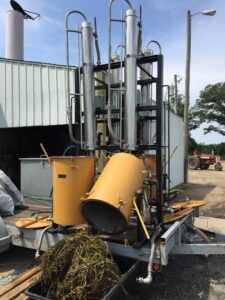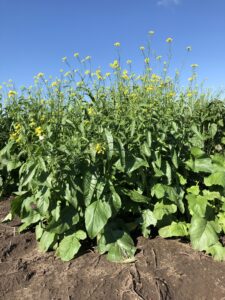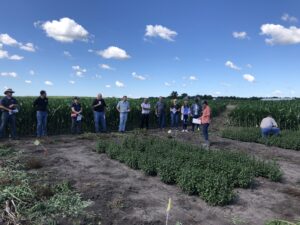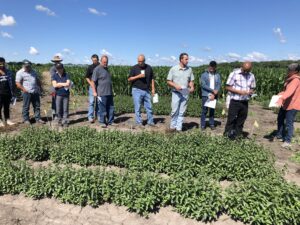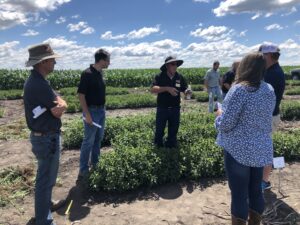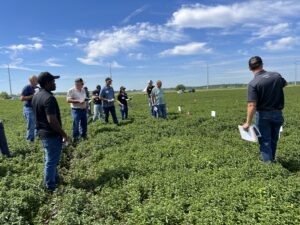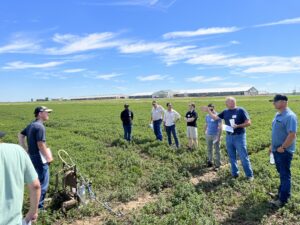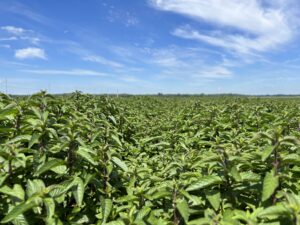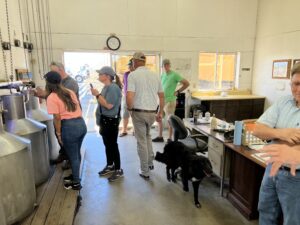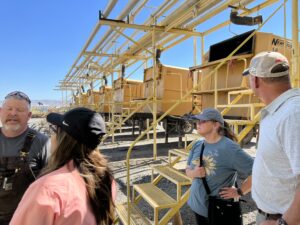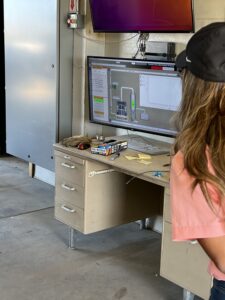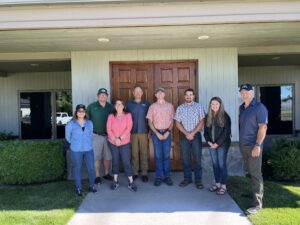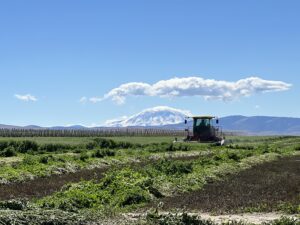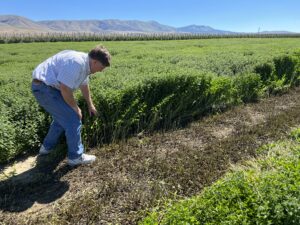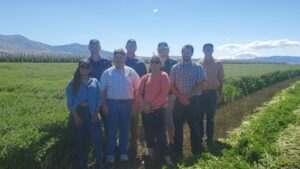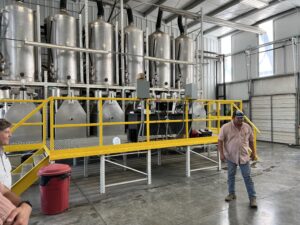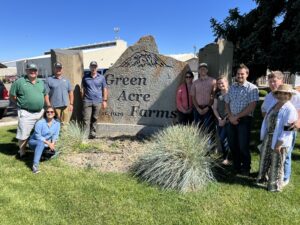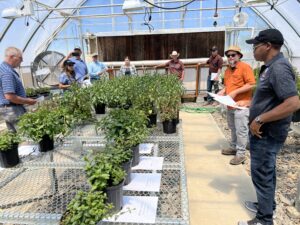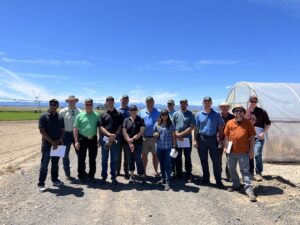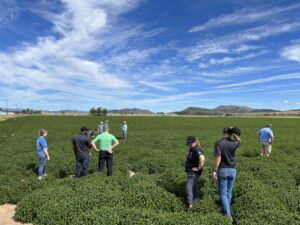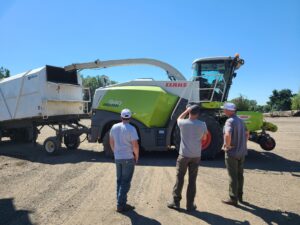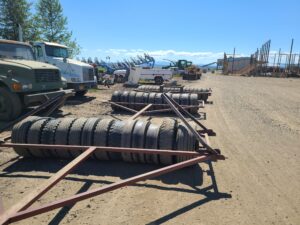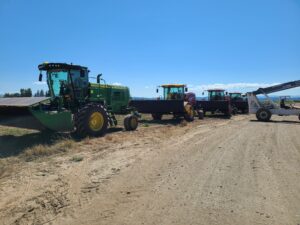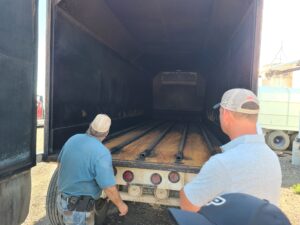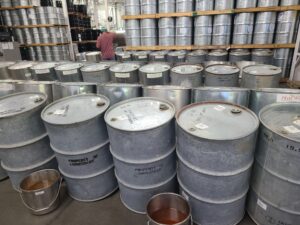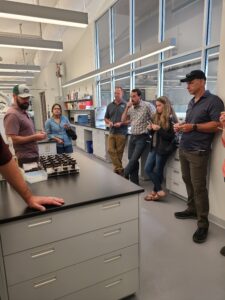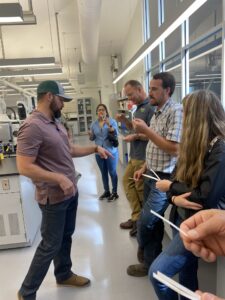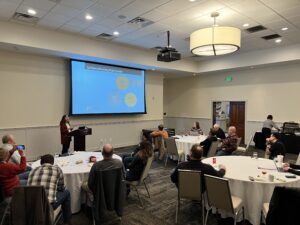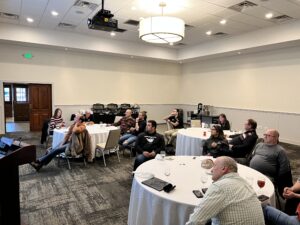Final report for LNC18-408
Project Information
Peppermint (cv. Black Mitcham) is a high-value crop grown for both its desirable oil composition and high yield. However, this crop is highly susceptible to Verticillium wilt, a devastating disease caused by Verticillium dahliae. While this perennial crop could traditionally be grown for five years, in recent years, mint stands have begun to decline after only three years, after which oil yields decline to such an extent that the crop needs to be replanted in another field. Growers are running out of suitable land that is free from Verticillium wilt. All mint cultivars grown commercially are sterile hybrids; therefore, traditional breeding for Verticillium wilt resistance has not been possible. Research to better understand the peppermint genome is underway, but breeding and releasing a resistant variety are still far away. Broad-scale fumigants can help suppress this disease but are prohibitively expensive. Moreover, these products can negatively affect beneficial soil microbes that provide key agroecosystem services.
This project worked closely with mint growers to evaluate their current cultural practices and design new production systems which integrate more holistic and sustainable practices. Midwestern mint growers were surveyed, and data was gathered to elicit farmers' decision-making processes, perceptions towards land availability, and technology adoptions. Participatory on-farm research trials were conducted to investigate the effect of biological approaches to remediate soils infested with V. dahliae. Approaches included a mustard cover crop and anaerobic soil disinfestation (ASD). A farmer-to-farmer education and outreach component included field days, workshops, online presentations with farmers, presentations at grower conferences and academic conferences, and a visit of Indiana growers to farms in Washington State and Oregon. Farmer experience guided the development of resource publications, which will be used across the state and the Midwestern United States. To increase farmer participation in this project, a farmer advisory committee was formed to guide research and outreach components. The farmer advisory committee included members of the Indiana Mint Market Development and Research Council (IMMDC).
Midwestern mint growers gained knowledge about alternative solutions for Verticillium wilt management. Knowledge gained from growers and research and outreach efforts translated into educational programs that were better equipped to fully support mint growers regionally to adopt enhanced sustainable agricultural practices.
The producer survey focused on management and cultural practices adopted to control Verticillium wilt. Findings from the survey highlighted the main practices in peppermint production among farmers in Indiana. The main findings include the age of the peppermint field, oil production (lb/acre), and planting strategies to prevent mint yield reductions due to pests. Efforts are underway to publish the results of this survey in an expert-reviewed Purdue Extension publication in 2023. The results of the greenhouse and field trials demonstrated that ASD has the potential to improve soils and contribute to an integrated management plan for the control of Verticillium wilt in mint. Further research is needed to identify the best substrates and rates to optimize ASD for controlling this devastating pathogen on the diverse types of soils that mint crops are grown on in the Midwestern U.S. However, researchers and growers are concerned about using tarps on a large scale. It is not sustainable and might not be financially viable. The use of ASD might only be feasible on a small scale, i.e., in a mint nursery. Further research into the economic aspects of ASD and the use of tarps needs to be conducted. The research further indicated that a mustard cover crop also has the potential to help suppress Verticillium wilt as part of an integrated management plan. However, further work is needed to optimize this practice as well. Several growers plan to incorporate a mustard cover crop in their rotation.
The project will document current mint production practices to identify key factors contributing to Verticillium wilt and identify opportunities to integrate more sustainable approaches to ensure long-term profitability. The potential for anaerobic soil disinfestation (ASD) and cover crops to mediate Verticillium wilt cost-effectively will be determined. Mint growers will learn how to conduct on-farm research and share information through a farmer-to-farmer network to ensure that results are disseminated and adopted. Adopting improved production innovations recommended from this project should lead to longer crop cycles, enhanced soil health and maintenance, improved economic viability, and better farmland use.
Mint is one of the most important specialty crops in the U.S. Midwest. Approximately 18,000 acres are currently planted to mint in this region, with an estimated annual value of $22 million. Traditionally mint was grown for five years, however, in recent years the production cycle has become limited to just three years, after which a new (virgin) field has to be identified for subsequent planting. This is mainly due to the soil-borne fungus (Verticillium dahliae) that causes Verticillium wilt, the most serious disease of mint. Verticillium wilt is a disease of the plant’s vascular system. The initial inoculum consists of microsclerotia (hardened fungal bodies), which are barely visible. Microsclerotia are produced internally in the plant and are released once the plant material decomposes. The fungus infects the roots and plugs the water-conducting tissue, which prevents water from reaching the upper plant parts. In the presence of the root lesion nematode (Pratylenchus penetrans), plants may develop earlier and more severe symptoms. Microsclerotia can be produced in large numbers and can survive in the soil for up to 15 years (Sunseri and Johnson, 2001). Other factors such as weed species serving as a pathogen reservoir, movement of contaminated equipment between mint fields, reintroduction of the pathogen following application of spent mint waste, and declining soil quality could also play a role in mint decline and susceptibility to Verticillium wilt. The most widely grown peppermint cultivar, ‘Black Mitcham’, is particularly susceptible to this disease. Verticillium wilt is a high priority for the Mint Industry Research Council. They are investing in programs at Washington State University and Oregon State University that investigate breeding of a Verticillium wilt resistant cultivar, mapping of the mint reference genome and analysis of V. dahliae diversity. However, because commercially grown cultivars are sterile, this is difficult using traditional breeding techniques and progress has been slow. Crop rotation is likely to be of little value since the disease can survive in the soil for many years. Currently the only effective solution is to find new (virgin) land for mint production. Although this has less negative environmental consequences compared to any chemical treatment, it is not sustainable.
The first step in overcoming these challenges is to document current production practices on mint farms. Detailed surveys of farmer practices and how these could contribute to the incidence and severity of Verticillium wilt will be critical to helping researchers and Extension educators begin to work with mint growers to develop and deliver cost-efficient solutions to this disease, as well as other production related problems that not only improve their profitability but ensure long-term sustainability. For example, we expect that integrating cover crops and green manures, or incorporating other organic amendments prior to planting, could help reduce this disease. Cover crops such as sorghum sudangrass, broccoli, and various mustards have been demonstrated to help suppress Verticillium wilt in potato and cauliflower (Davis et al., 1986; Subbaro et al., 1999; Dung and Weiland, 2018), but the direct link between cover crops and Verticillium wilt in mint has not yet been established.
A more aggressive strategy to revitalize soils currently infested with V. dahliae is ASD, a relatively new soil rehabilitation technique developed concurrently in Japan and the Netherlands. This approach involves amending soil with a labile organic substrate, saturating it with water and covering it with plastic to create anaerobic conditions. The process is thought to generate compounds that are toxic to soil borne pathogens such as V. dahliae as well as weed seeds and facilitate recolonization of beneficial soil microbes that enhance plant growth. ASD has recently been tested and demonstrated to be effective in mediating Verticillium wilt in U.S. strawberry production systems, which is also caused by V. dahliae. It is also currently being tested for its potential to mitigate soil-borne pathogens in Midwest high-tunnel production systems in a NCR-SARE funded proposal led by S. Miller at Ohio State University.
Cooperators
- (Researcher)
- (Educator and Researcher)
- - Technical Advisor (Educator and Researcher)
Research
Verticillium wilt (V. dahliae) is a devastating disease for peppermint growers. Current control practices include the use of virgin land for new plantings and the use of harsh chemical fumigants. Anaerobic soil disinfestation (ASD) is a novel technology that controls soil pathogens, parasitic nematodes, and weeds. Labile organic sources are used to rapidly deplete soil oxygen while creating compounds that help to increase the mortality of soil-borne pathogens and nematodes. We theorized that ASD could be a valuable tool for growers in their quest to control Verticillium wilt.
Producer Research
Over the past five years, the number of mint growers in Indiana has declined. Fewer mint growers emerged from the COVID-19 pandemic and related supply chain issues that resulted in higher input costs, while the price of mint oil has not increased. The three-year average peppermint oil yield has been consistent at around 68 pounds per acre.
According to a United States Peppermint & Spearmint 2022 Crop Report produced by Labbeemint, total U.S. peppermint production decreased by nearly 45% between 2018 and 2022. Production in 2022 decreased by 20% to 2.8 million pounds. Production in the Midwest was down by 19.7% in 2022 to 370,000 pounds. In 2022, peppermint production acreage nationally declined by 12.7% since 2018, while the Midwest acreage declined by 17.9% or 3,400 acres. Currently, there are about 11 growers in the Midwest (Indiana, Michigan, Wisconsin), producing peppermint on 5,600 acres.
The decisions to address mint pathogen pressure are complex. Moreover, the lack of available land has created additional challenges that mint farmers have had to address.
Purdue Extension partnered with scientists, Extension specialists, and growers to design, test, and conduct a mint production survey among Midwestern mint growers. The survey asked the growers about their growing practices, management practices, pests and pathogens, distilling practices, sales, and their perceptions of agriculture and operations. The survey gathered data to elicit farmers’ decision-making processes, selling arrangements, perceptions of land availability, and technology adoptions. With support from the Indiana Mint Market Development and Research Council, we sent the survey to commercial mint growers in Indiana and neighboring states. The survey was created on Qualtrics. A total of four responses were obtained. The low response rate was due to the number of mint growers willing to respond to the survey and the impact of COVID-19 on approaching growers in face-to-face events.
Greenhouse and On-Farm Participatory Research
Soil and plant samples were collected from several peppermint fields to quantify levels of V. dahliae incidence, identify fields for on-farm trials, and investigate how soil physical, chemical, and biological properties can affect the potential for this pathogen to survive and cause disease. Soil physical, chemical, and biological properties were determined using techniques commonly used in the Hoagland Lab and described in Rudisill et al. (2015). The abundance of V. dahliae populations in soil was determined using quantitative PCR as described in Bilodeau et al. (2012). Plant infection was confirmed by plating tissues on Sorenson’s NP-10 selective media (Kabir et al., 2004).
Preliminary greenhouse trials were conducted at Purdue’s Horticulture Plant Growth Facility in West Lafayette using three soils, nine soil treatments, and three- or five-week ASD incubation periods to identify the best treatments for the field trials. Treatments included an untreated and untarped control, a chemical fumigant (metam sodium) without tarping, solarization (tarped but no soil amendment) mustard cover crop (Caliente 199) untarped or tarped, ethanol (tarped), chicken litter (tarped), soybean seed meal (tarped), and dried distiller’s grain (tarped). The soils included one mineral (black sand) soil with 7.1% organic matter (OM) and two muck soils with 16.9 and 46.8% OM. Each treatment had 6 replicates. A virulent isolate of V. dahliae against mint was obtained from the ATCC, cultured on selective media, and added to the soils prior to treatment to ensure high pathogen levels were present. The incubation period was conducted in plastic jars, and probes were inserted in one replicate from each soil X treatment to monitor changes in soil temperature and pH. After ASD treatment, the soils were transferred to pots and planted with a clean mint stolon (cv. Black Mitchum). The plants were allowed to grow for four weeks. At harvest, the plants were rated for the incidence and severity of Verticillium wilt using a 0-4 rating scale, and above and belowground biomass was determined. The amount of V. dahliae in the soil and plant tissues at harvest was determined using qPCR and plates as described above. The entire experiment was repeated to confirm the results. Post-doctorate Sahar Abdelrazek and visiting intern Natalia Vidal conducted the greenhouse trials, and Post-doctorate Yi-Ju Wang assisted with the laboratory analysis of V. dahliae infection.
On-farm trials to evaluate the efficacy of ASD for mediating Verticillium wilt in mint were established on four farms with high levels of V. dahlia (two mineral and two muck soils). Funding was provided to compensate growers for their participation. Criteria for identifying on-farm research locations included soil type, the type of mint produced, soil health, level of Verticillium wilt infestation, and geographic location. Graduate student Patricia Stutz and several undergraduate interns, graduate students, and post-docs (Narda Trivino, Natalia Vidal, Jaime Zambrano, Amit Jaiswal, Alejandro Rodriguez Sanchez, Silenze Esquivel) assisted with the field trial. Each on-farm trial included seven treatments. Trials were arranged in a randomized complete block design with four replicates. Each experimental plot was 15 ft. in width and 15 ft. in length. Treatments included a mustard cover crop (cv. Caliente 199) with or without tarping, three locally available organic substrates that were most effective in our preliminary greenhouse trials (chicken litter, soybean seed meal, and dried distiller’s grains), solarization, and untreated control. The cover crop treatments were seeded at a rate of 10 lbs/acre, mowed and rototilled prior to treatment. The other ASD substrates were amended at a rate of 9.8 tons/acre and mixed into the soil at a depth of 6 inches prior to tarping. Soils in all treatments were saturated with water, and plots with the ASD and solarization treatments were covered with clear polyethylene fumigation film (tarp) for a period of one month during the summer. The untreated control and cover crop (untarped) were not covered. In one block at each farm, oxidation-reduction potential and temperature sensors were installed in each treatment to monitor soil redox (IRIS probes) and temperature during ASD treatment. After the soil treatment was complete, dormant mint stolons (cv. Black Mitchum) were planted early the following spring into each plot at a row spacing of 30 inches, three rows per plot. All plots were fertilized using standard grower practices and received no herbicide or fungicide treatments.
We had originally intended to implement our on-farm participatory research trials in 2019. However, we could not establish the trials due to a very wet extended spring followed by a very hot and dry period in June and July, which did not allow us to seed the cover crop on time. Instead, the project was implemented in 2020, and we could only collect one year of plant growth data in 2021 rather than two years as we had originally planned. Due to the delay in implementation, one of our farmer cooperators could not continue working with us, so we could only implement the trial on three rather than four farms as originally planned. We, therefore, established four field research plots at three different peppermint farms in Indiana. One plot at Gregg Kanne (Fair Oaks), a second plot at Dan Gumz (San Pierre), and a third and fourth plot at two locations on the farm of Randy Matthys (South Bend). However, we again experienced very poor cover crop germination at Dan Gumz's farm, so this location was dropped, and we continued with the research at the remaining three locations. Unfortunately, the farmer near South Bend inadvertently destroyed the two fields, so only the plot near Fair Oaks was planted with mint stolons in March 2021.
Soil samples were collected from each plot before treatment, at the conclusion of the month-long treatment, at planting, and just before harvest in August 2021. The health of the soil samples was determined in the Hoagland lab using the same techniques described above. In addition, the bacterial and fungal microbiome in soil samples collected just prior to harvest were determined using 16S/ITS, Illumina MiSeq, and various bioinformatic programs. Several students and post-doctoral research associates assisted with the soil analyses, including Yi-ju Wang, Alejandro Rodriguez-Sanchez, Marian Luis, Narda Trivino, Umut Bicum, Natalia Rodriguez, and Jaime Zambrano. The vigor of mint plants and incidence and severity of Verticillium wilt was recorded at five time points by Hoagland during the 2021 growing season. Plant samples were collected just prior to harvest in each plot to quantify biomass. Petrus Langenhoven and graduate students from the Hoagland lab recorded wet biomass in each plot. Langenhoven extracted mint oil through distillation at Greg Kanne's farm and recorded the total oil yield for each plot. Mint oil samples were analyzed free of charge by Labbeemint Inc, a mint oil buyer and processor based in Washington State, using GC-MS.
Statistical differences of all soil and plant parameters quantified were determined using ANOVA and means separation using Tukey (P<0.05) in SAS software. Soil microbiome assays were statistically evaluated using various programs in MOTHUR and R.
Producer Research
Results on producer economics include that peppermint species commonly found in Indiana include Black Mitcham, Murray's Mitcham, Robbert's Mitcham, and Todd's Mitcham. The average peppermint production reported by the five surveyed operations was 171.1 acres, with 99.3% of the area planted with Black Mitcham (170 acres). Only one grower reported growing 4 acres of Murray's Mitcham. All growers reported cutting their peppermint once a year. Three of the four growers reported using sustainable farming practices on their total acreage; the remaining grower followed conventional farming practices on 100% of their land.
We asked growers about the practices used to control Verticillium wilt in peppermint, which included chemical fumigation before planting, application of biological control products, and crop rotation. All farmers reported using crop rotation, and only one reported doing chemical fumigation before peppermint planting. Nematodes can be a significant pest in mint, causing stunted and dying plants and eventually leading to root death. Among the techniques used to control nematodes affecting mint, 75% of peppermint growers in our sample used crop rotation, while only one used chemical fumigation in addition to crop rotation.
The survey asked farmers' perceptions of peppermint production's most severe annual weeds. Pigweed was considered the most severe pest, followed by ragweed and lambsquarter. Most growers considered nightshade and velvetleaf not severe. All farmers in our sample reported using chemical herbicides to control weed populations; only one reported using hand weeding. The survey also asked growers about their perception of the severity of mint pests. In growers' experience, mint rust, mint bud mite, and Verticillium wilt were considered extremely serious. On the other hand, the Asiatic Garden beetle, nematodes (stem, spiral, pin, dagger, common needle, northern root, and false root), two-spotted spider mites, and mint flea beetle were considered as low- to medium-severity pests. Finally, cutworms, peppermint aphids, and Japanese beetle were considered non-severe.
Growers were asked about the importance of certain practices for the success of their farms. Labor availability, disease-free runners, fertilization management, and soil management were the most important practices in peppermint production, followed by disease management, sustainable practices, cultivar evaluations, and the need of certifications. The practices with the lowest importance for growers were insect management and weed control.
The survey asked peppermint growers how much land they rent or own. The survey results show that in 2021, an average peppermint grower had 160 acres used for peppermint production. This acreage is divided into rented land (59% of the total – 93.75 acres) and owned land (41% of the total – 66.25 acres. All growers responded that they received no financial assistance for their peppermint production. In 2021, all growers paid property insurance, 75% paid crop insurance and farm equipment insurance, and only 25% paid product liability, income protection, and worker compensation. For an average farmer in Indiana, peppermint has been grown and distilled for 27 years, and the peppermint operation has been running for 2.25 generations. The survey results show that 75% of the growers farmed their peppermint full-time, and only one farmer worked on his farm part-time in 2021. Labor plays an essential role in carrying out the different operations for peppermint production. We asked peppermint growers about family (including themselves) and nonfamily labor. The nonfamily labor was categorized into permanent employees, temporary or seasonal employees, and foreign migrant employees. An average peppermint grower had 6.25 workers distributed into 2.75 family members, two permanent employees, 1.5 temporary or seasonal employees, and no foreign migrant employees. Half of the respondents are limited liability companies (LLCs), and the other 50% are sole proprietorships.
Half of the respondents were in the age range of 25-44 years old. The ranges for the other half – 18 to 24 years old and 65-74 years old, were split equally. All respondents were male, and 75% of them reported a high school diploma. The education level of the other 25% was some college/vocational technical work.
Greenhouse and On-Farm Participatory Research
Results of the greenhouse trials indicated that V. dahliae was better at surviving in the muck than mineral soils, and the muck soils were generally less responsive to the ASD treatments in reducing soil pathogen populations. However, despite higher populations in the muck soils, stem infection in the mint plants was similar in plants grown in both soils, indicating that plants grown in the muck soils were healthier or there were more beneficial microbes present in the muck soils than in mineral soils that could reduce colonization in the mint plants. Alternatively, the mint plants may have a threshold at which infection occurs regardless of the level of the pathogen in the soil. Most ASD treatments significantly reduced V. dahliae infection relative to the control treatment, though the efficacy of the treatment varied among the soils. Across both experiments, the dried distiller's grain and mustard cover crop (with tarping) were the most effective. The mustard cover crop alone (no tarping) was also effective. None of the treatments, including the chemical fumigation, completely eliminated the pathogen. Plants grown in soil treated with ethanol were weaker and had higher levels of pathogen infection at harvest, indicating that this treatment harmed the plants and is not recommended. Treatments with the greatest impact on mint biomass also varied among the three soils; the most effective treatments were chemical fumigation, mustard cover crop (no tarping), and ASD with either dried distiller grains or soybean seed meal. The results of this trial confirm that the efficacy of ASD depends on soil type and the carbon substrates applied. Higher soil amendment rates may be needed on muck soils to effectively control the pathogen in these high organic matter soils.
Visual differences in the mint plots in the surviving field trial were dramatic. All three ASD treatments (chicken litter, dried distiller grains, and soybean seed meal) increased mint vigor and reduced the severity of Verticillium wilt symptoms. In contrast, the mustard cover crop treatment alone (no tarp) significantly reduced mint plant vigor and had higher Verticillium wilt severity. We suspect this may have been because the cover crop had regrown over the mild winter, and we had to cut and till in additional biomass just before transplanting the mint plants. This could have harmed the mint plants due to the release of allelochemicals from the cover crop as it was degraded and/or reduced the capacity for the mint plants to obtain nutrients like nitrogen that the soil microbial community may have immobilized as it was decomposing the cover crop residue. Mint plants grown in the solarization treatments also had greater levels of Verticillium wilt severity relative to the control treatments for reasons that are not well understood.
There were significant differences in first-year hay yield among the treatments; the highest yield was in the ASD-chicken litter and ASD-soybean seed meal treatments, which also correlated with the lowest disease severity. The lowest hay yield was in the mustard cover crop (no tarp) and solarization treatments, which were correlated with the highest disease severity.
There were no significant differences in total essential oil content among the treatments. However, there were differences in several individual essential oil components. For example, there was more Tmethnol in plants grown in soils with the cover crop (no tarp) treatment and higher levels of mentone in the plants grown in plots receiving the ASD-soybean seed meal treatment.
The treatments did influence the composition of soil bacterial and fungal microbiomes in the field plot. In particular, the composition of soil bacterial microbiomes in the ASD-chicken litter and ASD-soybean seed meal were significantly different than the control treatment, and the fungal soil microbiomes in the ASD-cover crop and ASD-soybean seed meal were significantly different than the control treatment. Moreover, the relative abundance of several distinct OTUs representing taxa, such as Alicylobacillus and Onygenacea were altered by the treatments and highly correlated with mint yield and essential oil components. This indicates that the impacts of ASD and implications on mint health and productivity are linked with distinct changes in the soil microbial community profile. Additional research into these changes will help optimize the application of this technology to suppress pathogens like V. dahliae and improve the productivity and quality of mint plants.
Producer Research
The survey focused on management and cultural practices adopted to control Verticillium wilt. Findings from the survey highlight the main methods of peppermint production among farmers in Indiana. The main results include the age of the peppermint field, oil production (lb/acre), and planting strategies to prevent mint yield reductions due to pests. Efforts are also underway to publish the results of this survey in an expert-reviewed Purdue Extension publication in 2023.
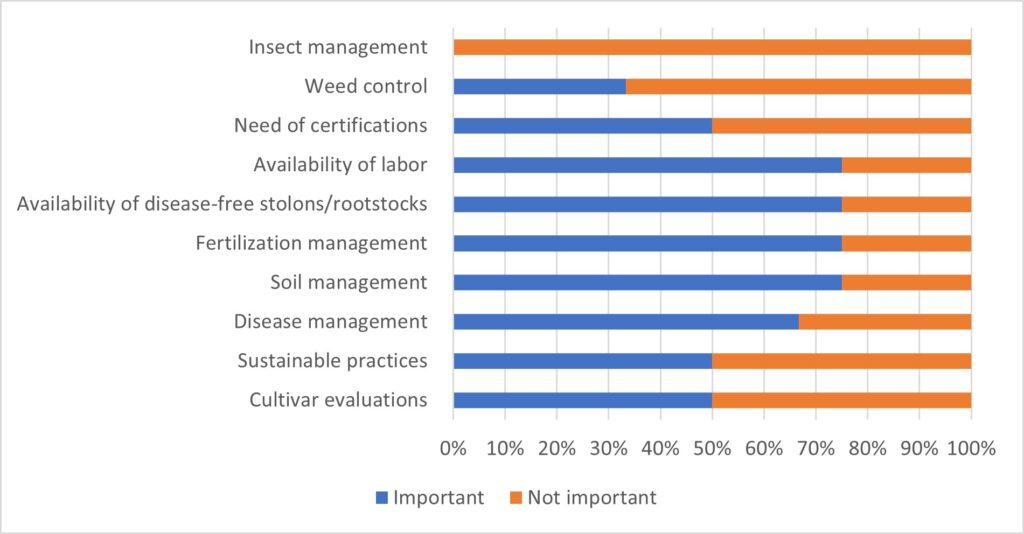
Greenhouse and On-Farm Participatory Research
The results of our greenhouse and field trials demonstrate that ASD has the potential to improve soils and contribute to an integrated management plan for the control of Verticillium wilt in mint. Further research is needed to identify the best substrates and rates to optimize ASD for controlling this devastating pathogen on the diverse types of soils that mint crops are grown on in the Midwestern U.S. However, researchers and growers are concerned about using tarps on a large scale. It is not sustainable and might not be financially viable. ASD might only be feasible on a small scale, i.e., in a mint nursery. Further research into the economic aspects of ASD and the use of tarps needs to be conducted.
Mustard cover crops also have the potential to help suppress Verticillium wilt as part of an integrated management plan, though further work is needed to optimize this practice as well. Several growers plan to incorporate a mustard cover crop in their rotation.
The final results of the greenhouse and field trials were presented at the annual American Society for Horticultural Science conference in Chicago, IL, during the summer of 2022, at the Indiana Mint Market Development and Research Council growers workshop at the Fair Oaks Dairy in IN, and at the annual Mint Industry Research Council meeting in Charleston, SC in January 2023. Efforts are also underway to publish the results of these trials in at least one peer-reviewed scientific publication that will be submitted in 2023.
Education
- Workshops at the Annual Midwest Mint Growers Conference covering relationships between soil health and pathogen dynamics, introduction to ASD and on-farm participatory research, and results of greenhouse experiments.
- Farmer panel discussions to share project results at workshops and regional grower meetings.
- Presentations of project findings at field days, workshops at annual grower meetings, and industry and scientific conferences.
- One farmer-to-farmer event with 6 participants.
- Graduate student and Post-Doc training in the characterization of Verticillium wilt and ASD experiments.
- Extension bulletin.
- Journal publication.
- A website dedicated to hosting mint research information.
- A YouTube playlist for Midwest Mint Growers.
Project Activities
Educational & Outreach Activities
Participation summary:
Annual SARE project workshops were conducted in 2019, 2020, and 2022 in conjunction with the Midwest Mint Growers Conference (Fair Oaks, IN) and the Indiana Mint Market Development and Research Council (IMMDC). Indiana, Wisconsin, and Michigan growers meet annually to discuss issues and learn more about mint production. This has been very successful. It is the best time of year to get all growers in one room. However, the COVID-19 pandemic prevented us from having workshops in 2021 and 2022. In coordination with the IMMDC, the SARE project research progress and results were recorded and presented online. In January 2023, the final SARE project workshop was held at Fair Oaks Farms, IN. Research findings and a report on the farmer-to-farmer tour were presented to Indiana Growers and stakeholders.
In 2020, the 43rd Annual Mint Industry Research Council (MIRC) Conference was held in Scottsdale, AZ. The conference was well attended by growers from the leading mint-producing states in the U.S. (California, Washington State, Oregon, Idaho, Indiana, Wisconsin, and Michigan), by mint oil buyers (Labbeemint, A&M Todd, Callisons, Northwest Ingredients), end-users (Wriggles, Colgate), and input suppliers. Dr. Langenhoven's represented the SARE project at the conference. He shared with growers about opportunities to integrate more sustainable practices to control Verticillium Wilt in peppermint. It also allowed him to present to attendees what our goals are with the SARE project. Langenhoven-MIRC_January 22, 2020. Due to the pandemic, the MIRC canceled the annual conferences in 2021 and 2022. In January 2023, we had an opportunity to present our research findings at the 44th annual Mint Industry Research Council Conference in Charleston, SC. Dr. Lori Hoagland presented our research findings to a very receptive audience.
In 2021, we established a playlist on the Purdue Extension YouTube channel, Indiana Mint Market Development and Research. The playlist educates farmers about mint farming, particularly Verticillium wilt in peppermint. The playlist currently consists of 12 videos and has been viewed 742 times.
Two successful field days were conducted during the project period, one in 2021 and another in 2022. Both field days were held at the farm of Greg Kanne, Fair Oaks, IN.
A farmer-to-farmer networking visit/tour to the Pacific Northwest was held from June 27 to July 1, 2022. The tour was very successful. Although we only had three Indiana growers on tour (one was the President of the IMMDC), interactions with growers and mint oil buyers from the Pacific Northwest were very successful. The tour group also included one Extension specialist, two Extension educators, and one graduate student. This tour would not have been possible without the coordination and staff commitment from Labbeemint, Yakima, WA.
We are currently developing a website dedicated to mint production. It will be published by June 2023.
Researchers are working on one peer-reviewed journal publication and one Extension bulletin. These publications will be published during 2023.
Learning Outcomes
- Anaerobic soil disinfestation
- Bio fumigation
- Producer decision-making process
Project Outcomes
To include mustard cover crop in the cropping schedule
